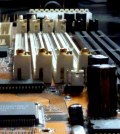 Waste electrical and electronic equipment (WEEE) is a growing problem, there are mountains of obsolete computers, mobile phones, refrigerators, televisions etc piling up on dumps around the world. Regulations implemented at the National and European levels seek to force those disposing of WEEE to recycle and reclaim the countless, often toxic, materials present in wiring, circuitry, electrical transformers, displays, casings, pipework.
Waste electrical and electronic equipment (WEEE) is a growing problem, there are mountains of obsolete computers, mobile phones, refrigerators, televisions etc piling up on dumps around the world. Regulations implemented at the National and European levels seek to force those disposing of WEEE to recycle and reclaim the countless, often toxic, materials present in wiring, circuitry, electrical transformers, displays, casings, pipework.
However, Anastasia Katsamaki and Nikolaos Bilalis of the Department of Production Engineering and Management, at the Technical University of Crete, suggest that we should be taking a step back from the recycling and reclamation paradigm and designing instead for the whole cycle and in particular at the end-of-life (EOL) stage of device design. This would from the outset cut down on the variety of materials employed, avoid the use of those likely to generate toxic residues and focus on the greening of gadgets.
The European Union implementation of 2002/96/EU Directive from August 2005 already demands that EOL issues are studied from the perspective of product disassembly, recycling, reuse and remanufacturing and from the perspective of design and technical support. But, while this has led to a lot of theorizing, and certainly pressure on the recycling schemes and landfill policies of local authorities, much remains to be done.
The researchers suggest that there are five objectives surrounding cutting down on WEEE:
- The efficient exploitation of natural resources used during the whole lifecycle.
- To promote reuse, remanufacture and recycling after the end of useful life .
- The use of materials with low environmental impact that are also readily recyclable.
- The minimisation of different materials used that simplifies their separation.
- The design of products that can be easily disassembled.
They have now shown how their objectives might be applied successfully to the example of electrical transformer design and so reduce the EOL impact of such a device. Their ongoing work will test the approach in other categories of device.
![]() Katsamaki A. & Bilalis N. (2012). Determination of redesign proposals to optimise end-of-life treatment of electrical and electronic equipment, International Journal of Product Lifecycle Management, 6 (2) 161. DOI: 10.1504/IJPLM.2012.052675
Katsamaki A. & Bilalis N. (2012). Determination of redesign proposals to optimise end-of-life treatment of electrical and electronic equipment, International Journal of Product Lifecycle Management, 6 (2) 161. DOI: 10.1504/IJPLM.2012.052675